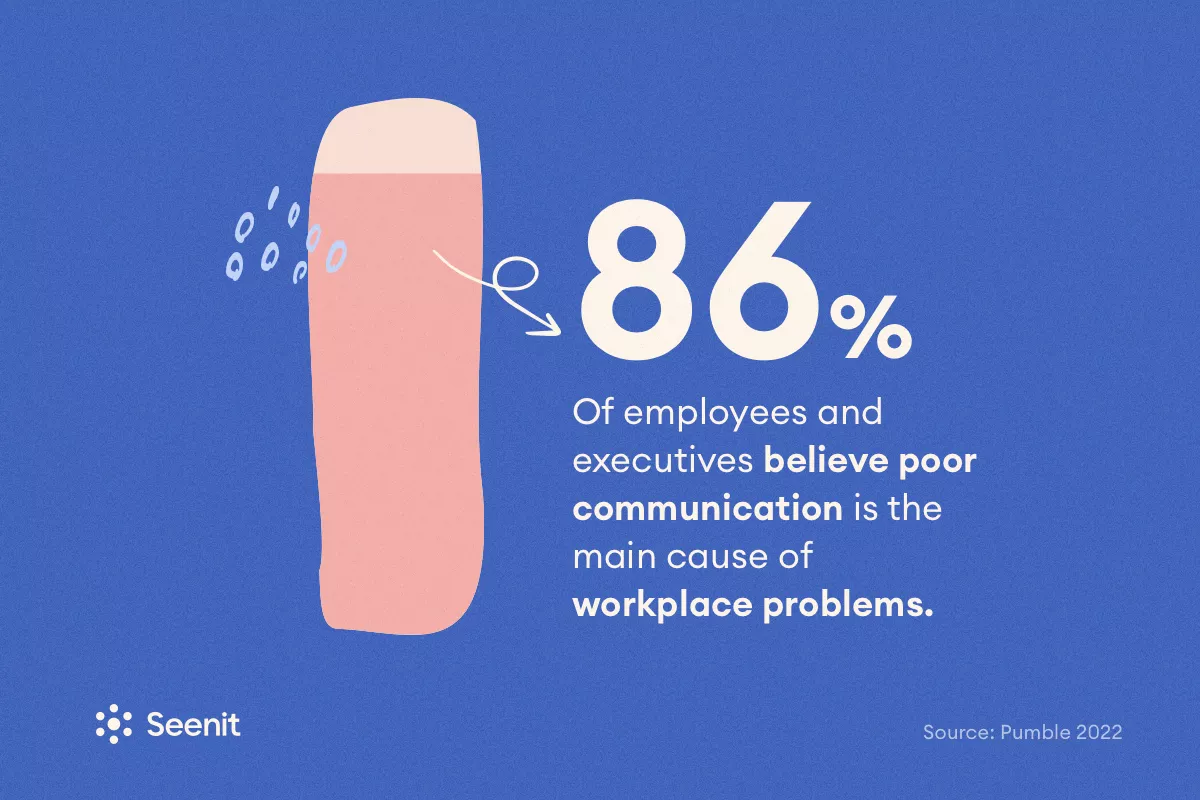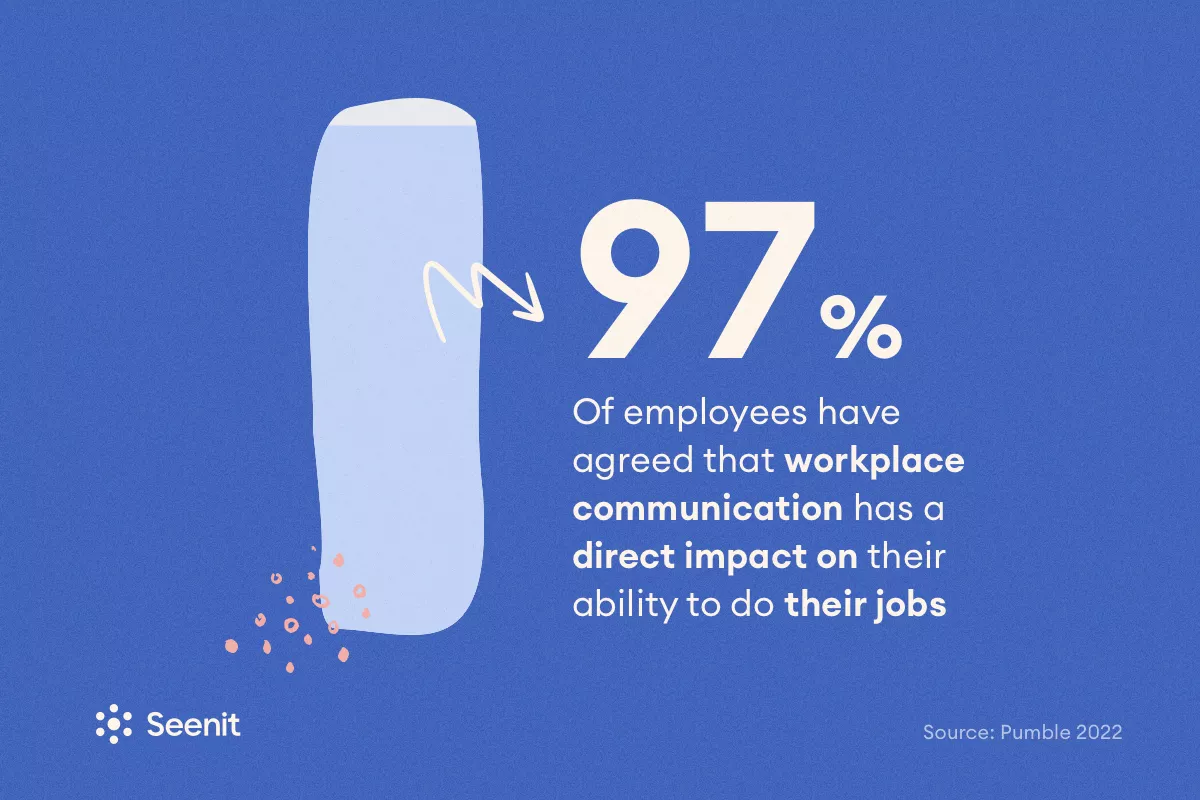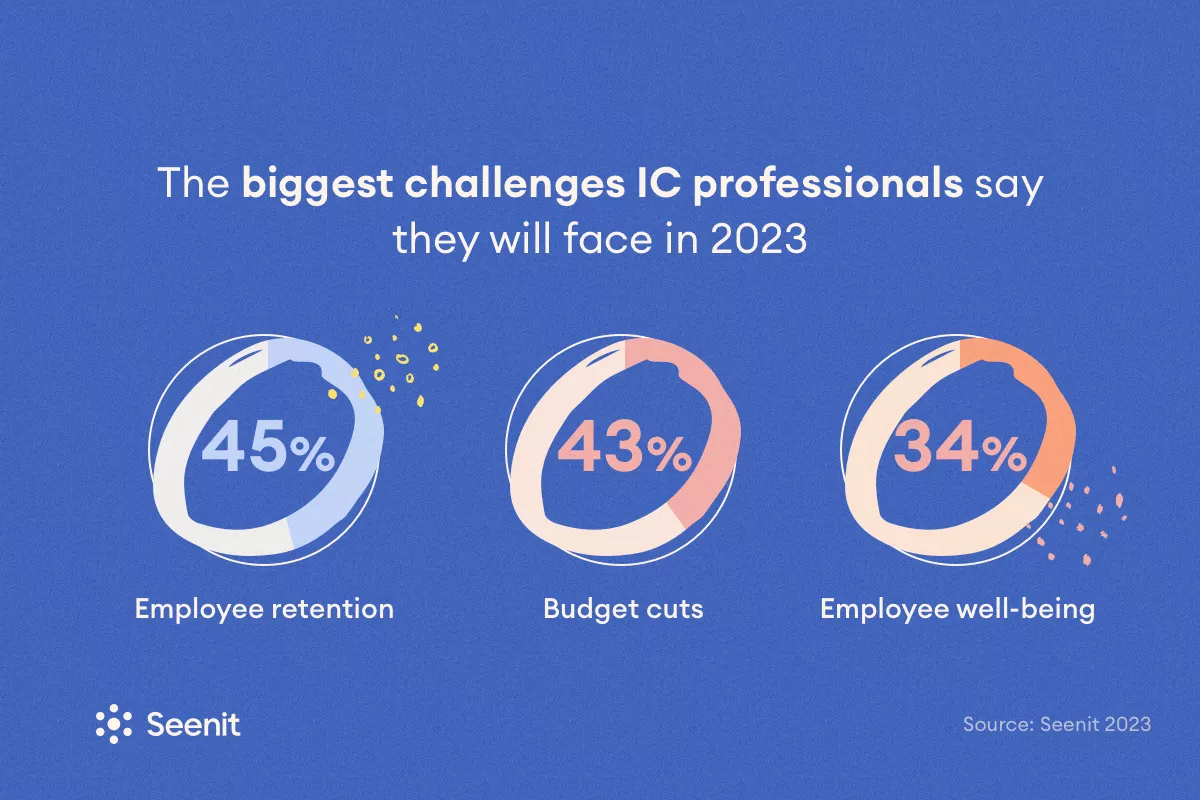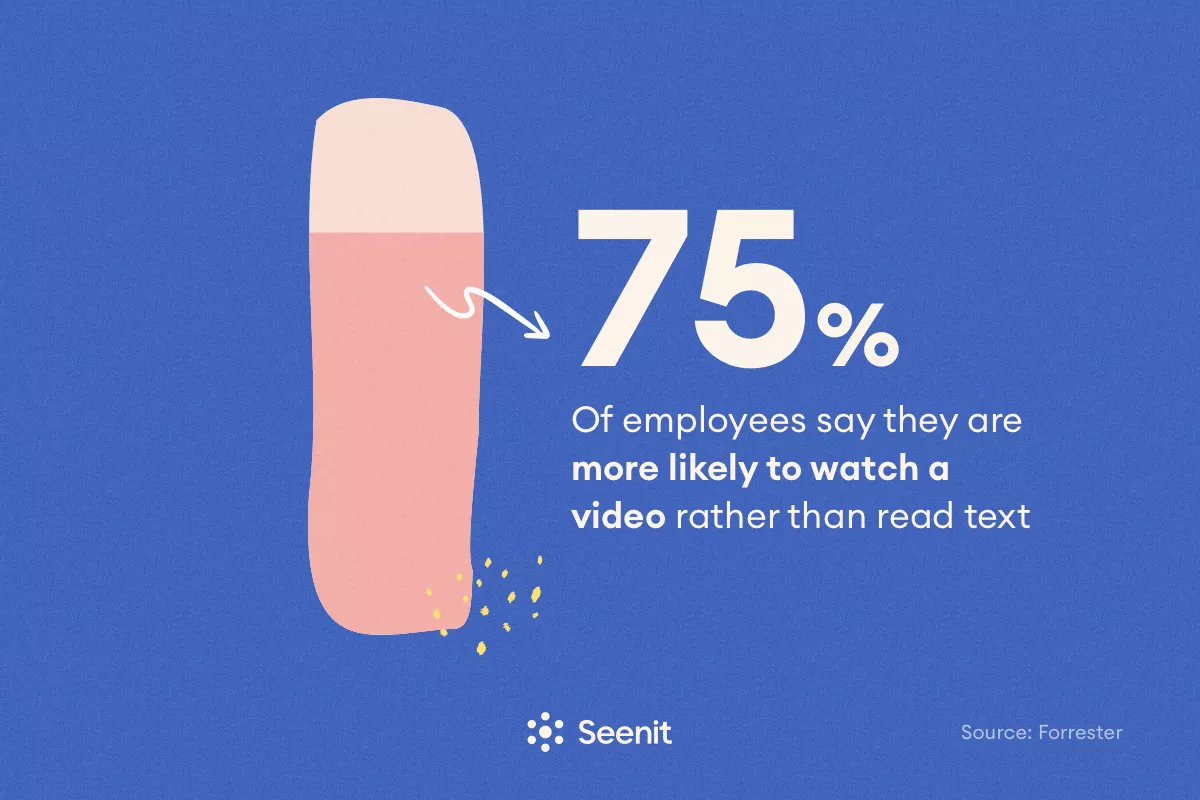Clear communication with and amongst employees is crucial whether you’re a small startup or a multinational billion-dollar company. Research shows that a huge 86% of employees and executives believe poor communication is the main cause of workplace problems.

In this guide, we’ll dive into what Internal Communications is, why it’s key to your business, and how you can communicate more effectively with your team — whether you’re looking to improve your current strategy or are crafting one from the ground up.
Let’s jump right in.
What is Internal Communications?
First things first, let’s get clear on what we mean by the term. ‘Internal Communications’ refers to the channels and methods a company uses to share information within an organisation. Amongst other things, it involves how everyone in the company shares news, gives feedback, and collaborates on projects.
The nature of Internal Communications has undoubtedly changed over time. Gone are the days when interactions were limited to face-to-face meetings or formal letters. New tech, as well as the increase in remote work, have given rise to new methods. Emails, shared calendars, instant messaging, and employee-generated videos have become the backbone of how we connect with our colleagues.
Types of Internal Communications
When we talk about Internal Communications, we’re looking at a whole range of ways organisations collect and share information. Here are some of the key types of communications to consider:
Formal communications
Think of formal communications as the more official channels: newsletters, all-team emails, and scheduled meetings. They play a crucial role in delivering consistent and important messages across the entire organisation, ensuring everyone stays informed.
Informal communications
These are the chats by the coffee machine or the quick messages sent through a team app. Though they might seem less significant, informal communications are crucial for building relationships and sharing day-to-day information.
Feedback channels
Feedback channels like surveys, suggestion boxes, and one-on-one meetings open up two-way communication, enabling everyone to voice their opinions and suggestions. This dialogue is essential for a healthy communication ecosystem.
Project communications
When teams collaborate on projects, regular updates, team catch-ups, and shared tools keep everyone aligned. They ensure that everyone is moving together towards the same goals and that they understand their roles and responsibilities.
Crisis communications
Direct and clear communication becomes even more critical in challenging times. Effective crisis communication ensures that all team members understand a situation and their roles in navigating it—maintaining order, morale, and confidence.
Training and development
Things like workshops, e-learning programmes, and training sessions enable teams to hone skills and share knowledge. They’re vital for personal growth and keeping a company competitive and innovative.
Why is Internal Communications important?
Internal Communications can make or break any business, regardless of your industry, structure, or size. And there’s plenty of research to back that up. For instance:
- 97% of employees said communication has a direct impact on their ability to perform their jobs
- 28% of employees blame poor communication for missing deadlines
- Poor communication has led to lost sales in 18% of companies, low morale in 31%, and missed performance goals in 25% of cases
- Effective communication can increase a team’s productivity by between 20 and 25%
- A company with an effective communication strategy has a 3.5 times higher chance of outperforming its peers

Internal Communications isn’t just about ensuring that things don’t go wrong. When communication flows well, it can also propel your entire team forward.
Benefits of a strong Internal Communications strategy
An effective Internal Communication strategy can shape the whole workplace environment. Here are some of the key benefits that one can bring to both your organisation and employees:
It boosts employee engagement
Good Internal Communication is one of the best ways to improve employee engagement. When team members feel included and aware of their role in achieving company goals, they are more likely to be engaged and invested in their work.
This has many knock-on effects for your company; in fact, studies have shown that companies with high levels of employee engagement are up to 21% more profitable.
Internal Communication videos can be a particularly accessible and cost-effective way for employers to improve employee engagement, as they often come across as much more personal and authentic than alternative methods like emails.
It increases job satisfaction and loyalty
A strong Internal Communications strategy can also improve employee retention, which is a key concern of 45% of professionals in the field. This is because employees tend to be happier in roles where they feel listened to and where good communication allows them to do their jobs well.

Indeed, effective team communication can increase employee retention by a factor of 4.5 compared to businesses that lack effective communication in the workplace.
It fuels productivity and innovation
Clear, concise communication also reduces misunderstandings and streamlines workflows, allowing employees to complete tasks more efficiently and effectively.
Without good communication, there’s a risk of people re-doing work that someone else has done, getting stuck on a project but not being able to ask for help, or feeling under-appreciated.
Open and clear communication also helps employees feel less stressed and more valued at work, which can, in turn, help them devise new, creative solutions to problems.
It builds a stronger, healthier culture
Internal Communications and company culture are closely intertwined. Consistent communication can help you reinforce your company’s values, mission, and vision, creating a positive workplace culture that resonates with every employee. Open and honest communication can also help rid the workplace of toxic behaviours like gossip and bullying.
If you’re trying to evolve your workplace culture in any way, Internal Comms will also be a key part of implementing these changes. Again, video can be a particularly effective technique here; check out these employee video ideas that can help you create a strong and positive corporate culture.
It improves crisis management
When updates aren’t as positive—e.g. job losses or hiring freezes—a good Internal Comms strategy can make all the difference. Done well, conscious communications keep everyone informed about situations, what’s expected of them, and how they can contribute to a solution, reducing panic and confusion.
It simplifies change management
Change can be disruptive and disconcerting for employees. That’s why there’s no such thing as too much communication when it comes to change management.
Whether it’s digital transformation, a mass restructuring, or managing culture change, effective communication helps manage employee expectations and eases the transition, ensuring everyone is on board.
How Internal Comms can support DE&I initiatives
Another major benefit of an effective Internal Communications strategy is its role in supporting Diversity, Equity, and Inclusion (DE&I) initiatives within a company.
To be effective, DE&I strategies must be fully integrated into business processes. That’s where Internal Communications can help. It offers a platform for sharing educational content, showcasing stories, and facilitating discussions—all of which contribute to a more inclusive workplace culture.
Implemented correctly, Internal Comms strategies can also promote diversity and inclusion by creating safe spaces for dialogue, such as forums and town hall meetings. And by highlighting achievements from diverse backgrounds, they inspire and underscore the value of diversity. This is crucial for companies looking to improve diversity in leadership.
Top tips for improving your Internal Communications
Ready to level up your Internal Communications strategy? Here are some top tips to help you ensure that messages are not just sent but also received, understood, and acted upon.
Make use of multiple channels
Different messages call for different delivery methods. For tough topics, like letting someone know about a job demotion or a pay cut, it’s usually best to talk face-to-face. This shows respect and makes the person feel acknowledged.
But not everything needs a meeting. If you’re just updating everyone on a deadline change, an email will do the trick—quick and straightforward. And for small things, like a broken coffee maker in the kitchen, a quick message in the group chat is perfectly fine.
Picking the right communication method helps you effectively communicate your message and keeps everyone in the loop without making things too complicated.
Increase engagement with video
Internal Communication videos are essential for keeping employees engaged and informed. They feel more personal, show the real faces behind a company, and capture employees’ attention better than words.
In fact, 75% of employees say they are more likely to watch a video rather than read text. They’re easier to focus on and can offer a pleasant break from other tasks.

Videos can also make learning easier and more effective, and they’re simple to share, helping messages reach employees wherever they are.
Know your employees
Understanding that everyone has their own preferred way of communicating is key. It’s helpful to take the time to get to know each person you work with. You could start by simply asking them how they like to receive information and what helps them do their best work.
Getting to know them a bit better personally, like what they enjoy doing outside of work, can make a big difference, too. People tend to feel more valued when they’re seen as individuals, not just as job roles.
Plus, tailoring your communication to include personal touches can make interactions more enjoyable and, by extension, more effective. Remember, we all have different communication styles, and adapting to these can greatly improve how we connect at work.
Be open and transparent
Keeping things clear and straightforward works best. It’s rare that hiding details or being vague is helpful. Most of the time, being open and honest makes everyone feel respected and valued.
This also cuts down on misunderstandings. Being transparent isn’t just about telling the truth; it’s also about not keeping things from your team, even when the news might be tough. Openness ensures everyone is on the same page, which is essential for a smooth-running team.
Record and follow-up
Managing communication well, especially with a big team, can be tricky. With everything that’s going on, it’s easy to lose track of the conversations you’ve had. That’s where taking notes and keeping records comes in handy. Even a brief chat deserves a note to remember what was discussed.
Using group messaging apps is a great way to keep track of these talks because you can always look back at what was said. More detailed notes can help you keep a clear record of all interactions.
It’s also super important to follow up on any issues your team members bring up, especially if you’ve said you will. If remembering to do so is a challenge, try using calendar apps to schedule reminders for yourself. This way, you won’t forget to check in again or arrange further discussions.
The future of Internal Communications
The world of Internal Communications is continually evolving. The way companies communicate today is completely different from how it was a few years back, not least because of the Covid pandemic. And it’s sure to keep changing.
In our The Future of Internal Communications report, we looked into what’s next for Internal Comms. We talked to lots of professionals and experts in the field and shared what we’ve learned from working with big names like Amazon, PayPal, Vodafone, and Trustpilot.
Our report is packed with insights and tips to help you stay ahead, face new challenges, and make your Internal Comms even better. Check it out if you want to be ahead of the game.
The role of employee-generated video in Internal Communications
Using videos made by your own employees can be a really effective way to improve Internal Communication. This is because creating engaging messages that connect with employees can be challenging, especially with ever-shortening attention spans.
But videos are great because they help people remember information better—95% of information is retained when in video format compared to 10% when in text. People also tend to engage more with content made by their peers rather than top leadership.
In short, employee-generated videos can capture your employees’ attention, keep them engaged, provide them with the tools they need, and help them collaborate effectively—all in a secure and accessible manner.
Here are some specific examples of ways to engage employees through video in your workplace. Keep in mind that Internal Communications videos can’t always be shared publicly, but the following can give you inspiration to get you started.
1. Recruitment videos
2. Onboarding videos
3. Training videos
4. Introduction videos
5. Leadership messaging
6. Recognition videos
7. Celebration videos
8. Announcement videos
9. Event announcement and summary videos
10. Project summary videos
Take your Internal Communications to the next level
Interested in incorporating employee-generated video into your Internal comms strategy? Seenit offers a platform that lets you use your employees’ smartphones to create videos. It puts your people and their voices front and centre in your communication.
Whether you’re running a larger campaign or a tactical project, you can quickly make employee-led videos from anyone in your organisation, no matter where they are.
Companies like H&M, Trustpilot, and EE have all used Seenit to create videos that increase engagement across their channels by up to 249%.



